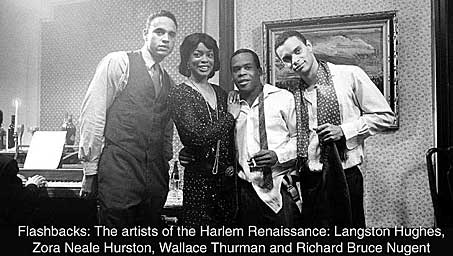
 |
||||||
|
GAY
FILM REVIEWS BY MICHAEL D. KLEMM
|
||||||
|
Brother to Brother Wolfe Video, 2004 Screenplay/Director: Rodney Evans Starring Anthony Mackie, Roger Robinson, Duane Boutte, Daniel Sunjata, Aunjanue Ellis, Larry Gillard Jr., Alex Burns Unrated, 94 minutes
|
Sentimental
Journey
Two generations, decades apart, of gay African-American artists collide in Brother to Brother, a wonderful film that celebrates the revolutionary writers of the Harlem Renaissance. The year is 1987. Perry Williams (Anthony Mackie) is a young black student. Thrown out of his parents' home for being gay, Perry is very militant about his homosexuality. He is seen, early on, debating other black students in class over the dismissal of author James Baldwin by 1960s civil rights leaders... simply because he was a black man who happened to be gay. His arguments are attacked. His straight friend Marcus chides Perry for a few liaisons he enjoyed with white men and Perry tells him that "the way you feel about white people is how the brothers feel about me being gay." The lovely words are part of "Smoke, Lilies and Jade" by Richard Bruce Nugent, and Perry learns that it was the first published story by a black man to address being gay. Perry is startled when he meets the old man again in the homeless shelter where he works and realizes that he is, in fact, the same writer. It saddens him that Nugent is now broke and forgotten. They become friends, and Nugent educates his new acolyte about his rebellious youth. Black & white flashbacks dramatize the days when he and his friends, Langston Hughes, Wallace Thurman, Zora Neale Hurston (and others) set out to change the landscape of African-American art and literature. |
 |
|
|
Nugent takes Perry to the old tenement in Harlem where he and his colleagues, most of them gay or bi-sexual, made their home. "We worked here," Nugent tells Perry, "but we played here even harder." They called it "Niggeratti Manor" and it was there that they published, in 1926, a single issue of the magazine Fire!! "With the new magazine, we will cease to look for respectability in the white person's eyes," declares Thurman. "If anything is deemed disturbing or pornographic, so much the better." Their work was daring and honest - perhaps too daring and honest because it was condemned, and even burned, by more "respectable" black leaders. "Upstanding Negroes didn't want no part of queers and whores," Nugent laments. It is the same today when gay critics complain that Queer as Folk features too much promiscuity and insist on "positive role models."
Brother to Brother almost overflows with ideas. Perry has a failed relationship with a white student, is frustrated by homophobia within the black community, and learns through his new mentor that, despite decades of progress, some things haven't changed. The fact that gay men were considered of little importance in the overall civil rights struggle is driven home by an imagined dialogue between James Baldwin and Eldridge Cleaver, one of the Black Panthers' founders. Baldwin expresses his anger over the movement's rejection of him while Cleaver regales him with cries of "You let the white man fuck you up the ass!" This occurs during a film that Perry's fellow students dismiss as being irrelevant. The film is beautifully acted and directed. Roger Robinson, as Nugent, reminded me of the late gay actor Paul Winfield. When he appears, the film becomes magical. The modern scenes and the flashbacks flow seamlessly into each other, and it was refreshing to witness the gay experience from an African American perspective for a change.
The screener DVD that I watched was unfortunately missing the extras, but I have read that the interview with writer/director Rodney Evans is very enlightening, and so is his commentary. Brother to Brother is proof that a film can be educational without forgetting to be dramatic and entertaining at the same time. It is the best new queer film I have seen this year.
More
on the Magazine Fire!! and the The real Bruce
Nugent can be seen in: |
|